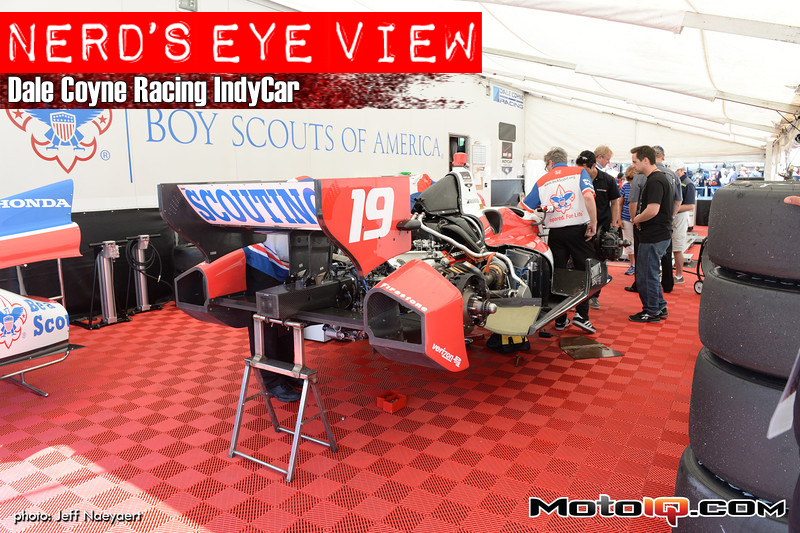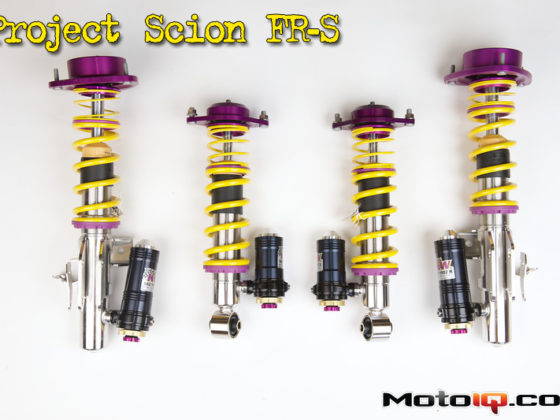
Nerd’s Eye View: Dale Coyne Racing IndyCar
The MotoIQ crew was roaming the IndyCar paddock during the Grand Prix of Long Beach hoping to get our eyes on some high-end race machinery. Getting up close with an IndyCar was more than we could have hoped for as it represents the highest form of open wheel racing for a US based series. Besides, it has turbos!
 Justin Wilson’s crew at Dale Coyne Racing was gracious enough to give the MIQ crew unlimited access to the car while the crew wrenched on it. One change this year from the previous year was the mandated use of a twin-turbo system whereas last year had the option of a single turbo setup. Wilson’s car uses the Honda Performance Development power plant. As you can see, each side of the car carries unique heat exchangers with one side cooling the coolant and the other side the oil.
Justin Wilson’s crew at Dale Coyne Racing was gracious enough to give the MIQ crew unlimited access to the car while the crew wrenched on it. One change this year from the previous year was the mandated use of a twin-turbo system whereas last year had the option of a single turbo setup. Wilson’s car uses the Honda Performance Development power plant. As you can see, each side of the car carries unique heat exchangers with one side cooling the coolant and the other side the oil. No thermostats are used on the car as they can be potential failure points and add complexity. Instead, simple block-off plates are used to cover parts of the heat exchangers to regulate temperatures.
No thermostats are used on the car as they can be potential failure points and add complexity. Instead, simple block-off plates are used to cover parts of the heat exchangers to regulate temperatures. The size of the openings in the side pods can also be adjusted by blocking off various amounts to adjust cooling.
The size of the openings in the side pods can also be adjusted by blocking off various amounts to adjust cooling.
 Packaged very tightly behind the heat exchangers on each side are the Borg Warner EFR 7163 turbos. These IndyCar turbos use V-band flanged turbine housings and external wastegates. The Honda power plant places the turbos as far forward as possible pushing them up against the heat exchangers. Chevrolet places the turbos more rearward roughly in-line with the last cylinder. Each arrangement has their positives and negatives. Honda decided to keep the wastegate and turbine exhaust flows separate whereas Chevrolet merge the two flows back together into a single big exhaust pipe exiting the bodywork.
Packaged very tightly behind the heat exchangers on each side are the Borg Warner EFR 7163 turbos. These IndyCar turbos use V-band flanged turbine housings and external wastegates. The Honda power plant places the turbos as far forward as possible pushing them up against the heat exchangers. Chevrolet places the turbos more rearward roughly in-line with the last cylinder. Each arrangement has their positives and negatives. Honda decided to keep the wastegate and turbine exhaust flows separate whereas Chevrolet merge the two flows back together into a single big exhaust pipe exiting the bodywork. Extensive heat shielding covers the exhaust manifolds and turbine housings. Heat equals energy and energy makes the turbos spin. It’s also nice to not damage the very expensive carbon fiber in close proximity to the hot bits. The wiring for the O2 sensors is protected in the orange insulation as electrical wires don’t react well to extreme heat either. The oil and water lines to the turbo and practically every line near the hot parts are similarly protected from heat by insulation. The big silver line attached to the top of the wastegate connects to the air box.
Extensive heat shielding covers the exhaust manifolds and turbine housings. Heat equals energy and energy makes the turbos spin. It’s also nice to not damage the very expensive carbon fiber in close proximity to the hot bits. The wiring for the O2 sensors is protected in the orange insulation as electrical wires don’t react well to extreme heat either. The oil and water lines to the turbo and practically every line near the hot parts are similarly protected from heat by insulation. The big silver line attached to the top of the wastegate connects to the air box.


